At What Age Do Rottweilers Naturally Calm Down?
Rottweilers are great dogs, but they are quite energetic and can be aggressive when young. So at what age do rottweilers calm down?
Rottweilers are hyper dogs, but by the time they are 24 months old, they calm down. Rottweilers have descended from stronger bloodlines, which makes them one of the perfect breeds for arduous tasks. However, their genes also contribute to their energy and aggression.
As Rottweiler owners, we feel it is our duty to educate people about the nature of these four-legged furry friends. Here, we will share more details about a rottweiler’s behavior and what you can do to calm them down.
What Causes Hyperactivity in Rottweilers after the Age of Three?
As discussed earlier, rottweilers tend to calm down by the time they are 24 months old. However, if their hyperactivity continues, it could be due to the following reasons.

Poor Training
Many owners and trainers believe that Rottweilers should have calmed down by the time they reach three years of age, but poor training can lead to ongoing issues with impulsivity and aggression.
The Rottweiler is a highly intelligent breed, but they need strong, consistent leadership from an early age to positively channel their energy.
Without proper guidance, they may continue to exhibit hyperactive or aggressive behaviors. Good training not only helps to prevent behavior problems, but it also strengthens the bond between pet and owner.
It’s never too late to start training, but starting early and staying committed to the process can make all the difference for a Rottweiler’s emotional development and overall well-being.
Lack of Exercise
One of the reasons why rottweilers fail to calm down after three years of age is lack of exercise. This includes not only physical exercise but also mental stimulation and training.
Without sufficient physical activity, rottweilers may channel their pent-up energy into destructive behaviors such as chewing and digging.
Lack of mental stimulation can also lead to boredom and restlessness, leading to problems with anxiety and aggression.
The key to maintaining a calm and well-behaved rottweiler is to provide them with plenty of opportunities for physical exercise and regular training sessions that engage their minds.
Neglecting these needs can seriously affect the dog’s behavior and overall health.
Simply taking your rottweiler on daily walks or providing them with interactive toys can make a world of difference in their demeanor.
Ignoring these needs, however, can result in a difficult-to-manage pup for years to come.
Fears and Insecurities

While it’s common for Rottweilers to retain their puppy-like energy and exuberance until about three years of age, some fail to calm down even after this point. One reason for this is fear and insecurities.
Just like any other animal, Rottweilers can struggle with feelings of fear and insecurity that can manifest in hyperactive or aggressive behaviors.
Without professional help, these fears and insecurities can continue to impact a Rottweiler’s behavior well into adulthood.
Owners need to work with their Rottweiler on addressing fears and building confidence early on, as well as seeking the guidance of a trained behaviorist if necessary.
Taking the time to address fears and insecurities can lead to a calmer, happier adult Rottweiler.
Some Good Outlets for Hyperactive Rottweilers
Agility Training and Courses
Rottweilers are known for their strength and boundless energy, making them excellent working dogs.
However, this also means they can get restless and destructive if not properly exercised. Agility courses and training provide an outlet for hyperactive Rottweilers, allowing them to channel their energy constructively.
Agility courses involve your Rottweiler navigating obstacles like jumps, tunnels, and weave poles under your guidance, improving their obedience and coordination.
Training focuses on tasks such as tracking and scent detection, providing mental stimulation and physical exercise.
Agility Courses and Training are fun activities for your Rottweiler that enhance their natural skills and overall behavior.
So next time your hyperactive Rottweiler starts causing trouble, consider enrolling them in Agility Courses or Training to give them the outlet they need.
Schutzhund
Schutzhund, also known as the German Protection Dog Game, is a popular sport among owners of high-energy breeds like Rottweilers.
This rigorous athletic activity challenges dogs mentally and physically, providing them with an engaging outlet for their energy and drive. Schutzhund includes three phases – tracking, obedience, and protection.
In the obedience portion of the sport, dogs must complete tasks such as retrieving objects on command and jumping over obstacles.
The protection phase tests the dog’s ability to defend its handler in simulated situations, while tracking involves following a scent trail set by a person on foot.
Schutzhund requires training and dedication from the dog and its owner, but it can be a rewarding outlet for a hyperactive Rottweiler’s instincts.
Plus, it may even result in improved behavior at home. Consider Schutzhund an enjoyable way to exercise and bond with your high-energy canine companion.
Advanced Obedience Courses
Advanced Obedience Courses are a great outlet for energetic and high-drive rottweilers.
These courses involve complex exercises that challenge the dog’s focus and impulse control, such as obstacle courses, directed retrieves, and duration sits and downs.
This mentally stimulating activity helps tire out a hyperactive dog and improves their overall obedience skills.
Advanced Obedience Courses also allow the handler to work on their leadership skills and improve their bond with their dog.
These courses can be a highly rewarding option for rottweilers needing an outlet for excess energy.
Hikes and Energy-Intensive Exercises
When it comes to satisfying a hyperactive rottweiler’s need for physical activity, hikes and energy-intensive exercises can be the perfect outlet.
In addition to providing necessary physical exertion, hikes offer mental stimulation for the dog as they navigate new terrain and interact with the environment.
Energy-intensive exercises like agility courses or participating in flyball or dock diving competitions provide even more opportunities for a rottweiler to exercise their mind and body.
It’s important to note that while hikes and energy-intensive exercises can be highly beneficial for a hyperactive rottweiler, it’s also important to ensure not to overexert them and allow for plenty of rest periods throughout the day.
Proper exercise can help keep your rottweiler happy and healthy physically and mentally.

Monitor Their Dietary Needs
One common reason for hyperactivity in dogs, particularly large breeds like Rottweilers, is a diet that is too high in energy and not balanced enough with nutrients.
While it may be tempting to use treats as a reward or give them table scraps, this can disrupt their nutrition and lead to excessive energy.
To maintain a calm demeanor in your Rottweiler, it is important to monitor their dietary needs and stick to a consistent feeding schedule.
This includes considering the type and amount of food they are consuming and avoiding giving them too many treats or table scraps.
Providing the right balance of nutrients can help keep your Rottweiler at a healthy weight and prevent over-excitement.
Reward Calmness
When dealing with a hyperactive dog, it can be tempting to resort to disciplinary measures such as scolding or punishment. However, these tactics do not address the root cause of the behavior and can often exacerbate the problem.
One effective way to calm a hyperactive rottweiler is to reward them for exhibiting calmness. This could mean giving them praise, a treat, or extra attention when relaxed.
Over time, this will reinforce the desired behavior and encourage the rottweiler to remain calm in stressful situations.
It’s important to remember that every dog is different and may require an individualized approach, but reward-based training can be a powerful tool for managing hyperactivity.
Key Takeaways
- One possible reason for this energy imbalance is genetics. Some rottweilers may have inherited a higher drive for activities like running, swimming, or fetching from their parents.
- Additionally, not meeting a rottweiler’s exercise needs can contribute to hyperactive behavior. It’s important to provide enough physical outlets for these strong, muscular dogs to keep them physically and mentally healthy.
- Another potential factor is diet. Providing an inadequate balance of nutrients or feeding too much can lead to excess energy and unnecessary weight gain.
- Lastly, proper training is crucial in teaching a rottweiler how to channel their energy appropriately. Hyperactivity often stems from boredom or a lack of structure, so motivating and engaging training sessions can help counteract this issue.

